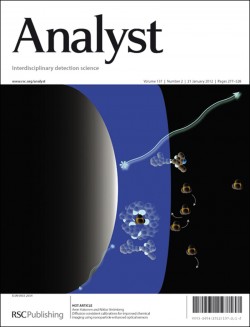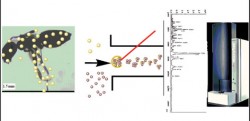 The second issue of 2012 is now online.
The second issue of 2012 is now online.
Featured on the front cover are Optical Chemical Sensors (Optodes), which have proven to be a versatile and powerful analytical tool often comparable or even better than traditional electrochemical sensors. In this study Aron Hakonen from the University of Gothenburg and Niklas Strömberg of the SP Technical Research Institute of Sweden show that a nanoparticle enhanced ammonium fluorosensor is suitable for non-invasive high-quality ammonium imaging of complex samples.
The plasmon sensitized optical sensors were utilized as a bioanalytical tool for chemical imaging of natural degradation processes occurring in biological tissues. Analytical performance of the nanoparticle enhanced sensors confirmed superior sensitivity, reversibility, durability and overall image quality over non-doped sensing membranes.
In addition, a straightforward square root function was utilized to improve image quality and simplify the calibration process.
They say that the nanoparticle interaction/coextraction based sensing scheme utilized in this study is general and can be used for numerous ions, preferably combined with the diffusion consistent calibrations for superior analytical performance.
Diffusion consistent calibrations for improved chemical imaging using nanoparticle enhanced optical sensors
Aron Hakonen and Niklas Strömberg
Analyst, 2012, 137, 315-321
DOI: 10.1039/C1AN15528H
On the back cover is work from Hui-Fen Wua and colleagues at the National Sun Yat-Sen University, Kaohsiung, Taiwan on the detection of bacteria using physical preconcentration coupled ZnO NPs assisted MALDI-MS (PP-MALDI-MS). Ants and humans coexist closely and for the most part happily, but this work shows that perhaps these insects aren’t as harmless* as they seem. Their study is an attempt to highlight the ability of these seemingly harmless ants to collect bacteria from their surroundings and transport them, and they confirmed that ants are potent carriers of bacteria and are good indicators of the bacteria present in the specific environment.
 Tracing the pathogen Staphylococcus aureus on laboratory ants using physical preconcentration coupled ZnO nanoparticle assisted MALDI-TOF MS
Tracing the pathogen Staphylococcus aureus on laboratory ants using physical preconcentration coupled ZnO nanoparticle assisted MALDI-TOF MS
Judy Gopal, Hui-Fen Wu, Chia-Hsun Lee and Muthu Manikandan
Analyst, 2012, 137, 357-364
DOI: 10.1039/C1AN15625J
These articles will be free for 6 weeks so take a look and let your colleagues know.
(*as someone who has been bitten by a soldier ant in the jungle, I have to disagree with the assessment of these insects as harmless!)










